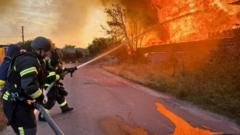Is Ukraine Facing Its Worst Attack Yet After Trump's Putin Critique?

Understanding the Current State of the Ukraine-Russia Conflict: An Analysis of Recent Developments
The ongoing conflict between Ukraine and Russia has escalated dramatically in recent weeks, culminating in what Ukrainian President Volodymyr Zelensky described as the largest aerial attack on Ukraine to date. With a staggering count of 728 drones and 13 cruise or ballistic missiles launched in multiple waves, the attack is a significant escalation in hostilities. This article aims to provide a comprehensive overview of these recent developments, the implications for Ukraine, and the reactions from global leaders, particularly focusing on the United States' involvement in the conflict.
The Scale of Recent Attacks
The overnight assault on Ukraine marked a disturbing new chapter in the conflict. Cities across the nation faced unprecedented bombardments, with the city of Lutsk, in particular, bearing the brunt of the attack. This city, located near the Polish border and acting as a critical transit hub for military and humanitarian aid, experienced severe destruction. Other regions, including Lviv and Rivne, were also targeted, demonstrating that no part of Ukraine is immune from Russian aggression.
The Impact on Civilians and Infrastructure
The recent aerial assaults have raised alarms regarding the safety of civilians and the integrity of Ukraine's infrastructure. As drones and missiles rain down on urban areas, the risk to civilian life escalates. Key infrastructures such as hospitals, schools, and transport networks are at risk of destruction, leading to potential humanitarian crises.
Military Response and the Role of the United States
In the wake of these attacks, the U.S. has announced a significant military aid package to Ukraine, reversing a previous suspension. President Donald Trump expressed frustration over Russian President Vladimir Putin's unwillingness to engage in meaningful negotiations for peace. The U.S. plans to send 10 Patriot missile systems to bolster Ukraine's defense against ongoing aerial threats. As Ukraine continues to rely heavily on these interceptors, the support from the U.S. becomes increasingly crucial.
The Diplomatic Landscape
Despite efforts aimed at establishing a ceasefire, both Russia and Ukraine remain entrenched in their positions. President Zelensky condemned the recent attacks as a blatant rejection of peace initiatives, stating that while Ukraine seeks diplomatic resolutions, Russia continues its offensive. The skepticism surrounding the prospect of diplomacy is palpable, with the two nations having held only two rounds of ceasefire talks earlier this year with no further discussions scheduled.
What’s Next for Ukraine? Military and Strategic Considerations
The situation in eastern Ukraine continues to evolve, with Russia launching a summer offensive that has shown no signs of abating. Kremlin spokesperson Dmitry Peskov characterized the ongoing Russian operations as a new reality that Ukrainians must accept. This statement highlights the stark difference in perspectives between the two nations, with Russia seemingly committed to its military objectives regardless of international repercussions.
The Global Reaction: Allies and Adversaries
International reactions to the conflict have varied widely. The U.S. has been a significant supporter of Ukraine, offering military aid and humanitarian assistance. On the other hand, Russia's actions have drawn condemnation from many Western countries and have been met with sanctions and diplomatic isolation. The responses from global leaders indicate a complex interplay of alliances and geopolitical strategies that will likely shape the future of the conflict.
The Role of NATO and European Allies
NATO has reinforced its commitment to Ukraine, understanding that the security of Europe is at stake. The alliance has increased its military presence in Eastern Europe and has provided various forms of support to Ukraine. These actions are part of a broader strategy to deter further Russian aggression and to reassure Eastern European nations that they are not alone in facing potential threats.
Economic Consequences of the Conflict
The war has had profound economic effects on Ukraine and its allies. The destruction of infrastructure, displacement of populations, and disruption of trade routes have all contributed to economic instability in the region. Additionally, Western nations are grappling with the economic ramifications of sanctions against Russia, which have led to increased energy prices and inflationary pressures.
Humanitarian Impact and Refugee Crisis
The conflict has triggered one of the largest refugee crises in recent history, with millions of Ukrainians forced to flee their homes. The United Nations has reported significant internal displacement and cross-border migration, creating urgent needs for humanitarian assistance. Countries bordering Ukraine have been particularly affected, as they manage the influx of refugees while striving to provide essential services and support.
Conclusion: The Path Forward
As the conflict continues to unfold, the potential for a peaceful resolution remains uncertain. Both sides appear entrenched in their positions, and the recent aerial assaults serve as a stark reminder of the stakes involved. President Zelensky’s condemnation of the attacks and the U.S. military support signal that Ukraine is not backing down in its efforts to defend its sovereignty.
The international community’s response will play a pivotal role in shaping the future of the conflict. As nations grapple with the implications of the war, the focus must remain on humanitarian efforts and diplomatic avenues to achieve lasting peace. Whether a resolution can be reached in the near future remains to be seen, but the resilience of the Ukrainian people and their determination to fight for their freedom is undeniable.
FAQs
What triggered the recent escalation of conflict between Ukraine and Russia?
The recent escalation was triggered by a significant aerial attack from Russia involving 728 drones and multiple missiles, occurring amidst ongoing efforts for peace and ceasefire negotiations.
How is the United States responding to the conflict in Ukraine?
The U.S. has reversed its decision to suspend military aid to Ukraine and is sending additional support, including 10 Patriot missile systems, to bolster Ukraine's defense against ongoing Russian attacks.
What are the humanitarian implications of the Ukraine-Russia conflict?
The conflict has led to a large-scale refugee crisis, with millions displaced and in need of humanitarian assistance. The destruction of infrastructure also poses significant challenges for civilians remaining in conflict areas.
As the situation continues to evolve, what do you believe is the best path forward for achieving lasting peace in Ukraine? #UkraineConflict #MilitarySupport #GlobalPeace
Published: 2025-07-09 10:35:08 | Category: world



